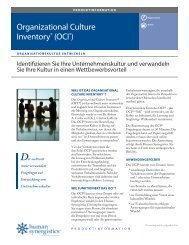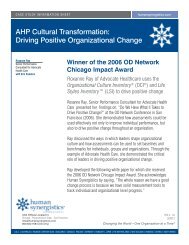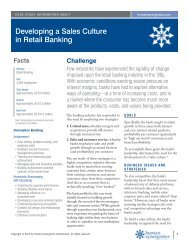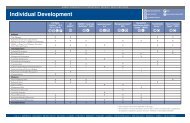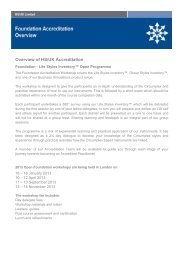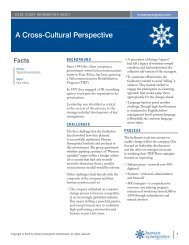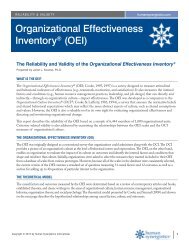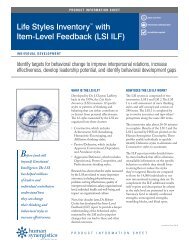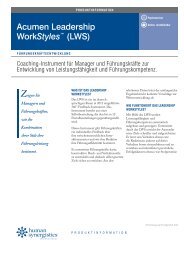High Potential…to Do What? - Human Synergistics
High Potential…to Do What? - Human Synergistics
High Potential…to Do What? - Human Synergistics
Create successful ePaper yourself
Turn your PDF publications into a flip-book with our unique Google optimized e-Paper software.
ARTICLE<br />
humansynergistics.com<br />
<strong>High</strong> <strong>Potential…to</strong> <strong>Do</strong> <strong>What</strong>?<br />
Janet L. Szumal, Ph.D.<br />
<strong>Human</strong> <strong>Synergistics</strong>/Center<br />
for Applied Research, Inc.<br />
summary<br />
Most high potentials are selected on the<br />
basis of their technical talent and the extent<br />
to which their behaviors exemplify and<br />
promote their organizations’ operating<br />
cultures—the norms and expectations<br />
that represent how things actually get<br />
done—which often are quite different than<br />
their organizations’ highly touted visions<br />
and values. As a result, organizations have<br />
become very good at promoting high<br />
potential individuals for doing more of the<br />
same. This article highlights what talent<br />
managers need to look for and develop in<br />
their high potentials (and the commonlymade<br />
mistakes they should avoid) to move<br />
their organizations toward realizing their<br />
visions, values, and goals.<br />
Your company has just identified its “high<br />
potentials”—the rising stars amongst<br />
your organization’s ranks. According to<br />
a recent article, high potentials are those<br />
who outperform their peers and “exhibit<br />
behaviors that reflect their companies’<br />
cultures and values in an exemplary manner”<br />
(Harvard Business Review, June 2010,<br />
p. 80). This assumes that the operating<br />
cultures of organizations—that is, how<br />
things are currently done and what’s really<br />
expected—are aligned with their visions and<br />
values—that is, what they say is important<br />
and want to achieve. The Organizational<br />
Culture Inventory® has been used to<br />
quantitatively measure and compare the<br />
operating cultures to the stated values of<br />
thousands of organizations and rarely do<br />
they match—and in many cases are quite<br />
different. Furthermore, data on the impact<br />
of managers and leaders, including high<br />
potentials, show they tend to encourage the<br />
people around them to behave in ways that<br />
are more consistent with their organization’s<br />
operating culture than its values.<br />
Certainly there are organizations that live<br />
their values and promote managers who<br />
exemplify and reinforce them. Unfortunately,<br />
they seem to be in the minority. Based<br />
on the research of culture and leadership<br />
expert Dr. Robert A. Cooke, along with<br />
Dr. Janet L. Szumal, operating cultures are<br />
created and reinforced by the behavior and<br />
decisions of the organization’s leadership and<br />
management and the systems, structures, and<br />
technologies they put in place, all of which<br />
people inside the organization have to deal<br />
with on a day-to-day basis (The Handbook<br />
of Organizational Culture and Climate,<br />
2000). And the truth is that rising stars<br />
usually aren’t those who rebel against their<br />
organization’s management and leadership.<br />
Instead they tend to be your “good soldiers”<br />
—exemplifying their organization’s operating<br />
culture, regardless of whether it is consistent<br />
with its values.<br />
For talent managers, this means taking a<br />
critical look at your company’s criteria and<br />
practices for high potentials to ensure that<br />
they identify and develop the potential for<br />
moving your organization closer toward its<br />
vision, values, and goals.<br />
Step 1: Identify Your Organization’s Values<br />
This sets the foundation for establishing your<br />
organization’s criteria and practices for high<br />
potentials. Most organizations publish their<br />
© Copyright 2010<br />
<strong>Human</strong> <strong>Synergistics</strong> International<br />
1
ARTICLE<br />
humansynergistics.com<br />
<strong>High</strong> <strong>Potential…to</strong> <strong>Do</strong> <strong>What</strong>?<br />
values in employee handbooks, company<br />
reports, and on their websites. If they are not<br />
explicit or if it is questionable whether they<br />
are still relevant, consider using a validated<br />
survey to identify them. The advantage of<br />
this approach is you can gather information<br />
from a variety of people in the organization<br />
relatively quickly and inexpensively. Though<br />
an organization’s values are usually defined<br />
by its leadership, data from a variety of<br />
people enables you to gauge the extent to<br />
which those values are shared.<br />
An organization’s values should support and<br />
reflect its mission and vision and promote<br />
its long-term effectiveness. Interestingly, for<br />
just about every organization, what we call<br />
“Constructive” thinking and behaviors top<br />
the list. This type of thinking and behavior<br />
is driven by what psychologist Abraham<br />
Maslow called “higher-order needs” to take<br />
responsibility and achieve, develop mutually<br />
satisfying relationships, develop oneself<br />
and others, and continuously improve.<br />
In organizational settings this requires a<br />
balanced focus on both task and people—<br />
tasks need to be coordinated and done well<br />
and relationships need to be genuine and<br />
productive. The quest to make these values<br />
part of the operating culture is well worth it.<br />
Research shows that Constructive operating<br />
cultures are associated with a number of<br />
desired outcomes including profitability,<br />
sales growth, product and service quality,<br />
teamwork, and employee motivation,<br />
satisfaction, retention, and well-being.<br />
Step 2: Use Your Organization’s Values to<br />
Identify <strong>High</strong> Potentials<br />
For example, if your organization values<br />
responsibility and accountability, cooperation,<br />
and continuous improvement then these<br />
should be exemplified by the behavior<br />
of high potentials. However, most<br />
organizations make two major errors when<br />
using their values to identify high potentials:<br />
• They focus on the results achieved and<br />
assume that high potentials behaved in<br />
ways consistent with their organizations’<br />
values.<br />
Assumptions about behavior based<br />
on results or other outcomes are not<br />
always correct—and we have outstanding<br />
organization (e.g., Enron) and industry<br />
(e.g., banking) examples that demonstrate<br />
the dangers of making these assumptions.<br />
• They exclusively rely on reports by<br />
higher-level leaders and peers.<br />
How people behave around higher-level<br />
managers and peers is not necessarily how<br />
they come across to direct reports—and<br />
those who want to be high potential<br />
know they have to look good to those<br />
who have the power to promote them.<br />
Thus, you need to directly assess rather<br />
than make assumptions about how high<br />
potentials achieve results. Observe them<br />
in action, ask them how they achieved a<br />
particular result(s), and talk with people<br />
who work with them, including their direct<br />
reports (and, preferably, not just their<br />
favorites).<br />
Step 3: Evaluate the Impact of <strong>High</strong><br />
Potentials on the People around Them<br />
Management and leadership are about<br />
bringing out the best in others. This means<br />
also asking people—including direct reports<br />
and peers—about the impact that high<br />
potentials have on them. Data on managers<br />
at all levels of organizations show that those<br />
who drive defensive, self-protecting or<br />
self-promoting behaviors are less effective<br />
at moving their organizations toward their<br />
vision and goals; create insecurity, stress, and<br />
dissatisfaction amongst the people around<br />
them; make people want to leave; and are<br />
not perceived as ready for their current<br />
position (much less promotion to a higherlevel).<br />
In contrast, managers who motivate<br />
people to behave in Constructive ways are<br />
viewed as highly effective at moving their<br />
organizations toward their visions and<br />
goals; foster a greater sense of confidence<br />
© Copyright 2010<br />
<strong>Human</strong> <strong>Synergistics</strong> International<br />
2
ARTICLE<br />
humansynergistics.com<br />
<strong>High</strong> <strong>Potential…to</strong> <strong>Do</strong> <strong>What</strong>?<br />
and satisfaction amongst the people around<br />
them; make people to want to stay; and<br />
are perceived as energized and ready for<br />
promotion.<br />
Step 4: Assist <strong>High</strong> Potentials in<br />
Understanding their Current Impact<br />
Chances are your high potentials approach<br />
certain responsibilities effectively from an<br />
impact on others standpoint but, perhaps<br />
in order to get things done quickly or look<br />
good, inadvertently do other things in ways<br />
that, long term, have a detrimental impact<br />
on the organization. Unfortunately, the<br />
feedback provided by most organizations<br />
often focuses on whether high potentials<br />
carry out their responsibilities rather than<br />
how they carry them out. Data on a variety<br />
of managers, including high potentials,<br />
shows that different ways of approaching<br />
the same responsibility yields a different<br />
impact on other people. Consider, for<br />
example, the responsibility of managing<br />
work activities. <strong>High</strong> potentials who provide<br />
others with autonomy and check if people<br />
are able and willing to do a task before they<br />
delegate it motivate those around them to<br />
take initiative, plan their own work, and<br />
coordinate and cooperate with others. In<br />
comparison, high potentials who dictate<br />
the details of assignments and unilaterally<br />
commit people to projects and deadlines<br />
drive those around them to simply obey<br />
orders without question, build and maintain<br />
their own power bases, and avoid the<br />
appearance of any errors or mistakes.<br />
Providing high potentials with feedback<br />
from others on how they approach their<br />
responsibilities and the impact it has on<br />
the people around them enables them<br />
to see how certain approaches, though<br />
possibly effective in the short run, are<br />
counterproductive from a broader, longerterm<br />
perspective. Supplement this feedback<br />
by asking high potentials to describe<br />
how they carry out particular activities.<br />
Then identify with them more effective<br />
language, practices, and approaches in<br />
terms of the impact on other people.<br />
Finding ways to modify their approach to<br />
certain responsibilities can enhance their<br />
effectiveness in their current role as well as<br />
prepare them for future roles, where the span<br />
of their impact likely will be greater.<br />
Step 5: Establish Commitment to and<br />
Accountability for Self-Development<br />
Those selected as high potential may not<br />
necessarily have a highly Constructive<br />
personal style and impact on the people<br />
around them right from the start,<br />
particularly if they were strictly selected on<br />
the basis of their accomplishments. And<br />
some of them—because of the operating<br />
culture, their managers, or the behaviors<br />
that worked for them in the past—may<br />
not understand that they’re responsible for<br />
making their organizations’ visions and<br />
values a reality. If you have people who really<br />
don’t buy into the organization’s vision and<br />
values, it’s better to find that out before<br />
you promote them rather than after they<br />
are holding one of the top positions. By<br />
comparing their current behavior and impact<br />
on other people to your organization’s<br />
values, you’ll be able to discuss what they<br />
need to do to develop the behaviors and<br />
skills that differentiate truly great managers<br />
and leaders from those who get shortterm<br />
results regardless of the longer-term<br />
effects. <strong>High</strong> potentials who commit to<br />
this investment will need their managers’<br />
support. Often management development<br />
programs go nowhere because ongoing<br />
support and accountability for achieving<br />
these types of goals is lacking. Consequently,<br />
some organizations now require as part<br />
of their programs that participants share<br />
their development goals and strategies<br />
(but not necessarily their feedback) with<br />
their immediate supervisors or managers<br />
who, in turn, incorporate them in future<br />
performance evaluations. In this way,<br />
the developmental feedback received by<br />
participants remains confidential yet they are<br />
held accountable for acting on it in ways that<br />
© Copyright 2010<br />
<strong>Human</strong> <strong>Synergistics</strong> International<br />
3
ARTICLE<br />
humansynergistics.com<br />
<strong>High</strong> <strong>Potential…to</strong> <strong>Do</strong> <strong>What</strong>?<br />
further develop their potential to contribute<br />
to their organization’s goals and maximize<br />
its long-term effectiveness.<br />
<strong>High</strong> potentials can be identified by finding<br />
high performing individuals who exemplify<br />
the organization’s values and motivate the<br />
people around them to do the same. More<br />
commonly, however, they are selected solely<br />
on the basis of the results they achieve—<br />
with the hope that they’ll be willing and<br />
able to develop the skills and abilities<br />
required to take their organization to the<br />
next level. The latter approach is obviously<br />
more difficult than the former. By following<br />
the steps outlined here, you can strengthen<br />
your organization’s potential for realizing its<br />
longer-term vision, values, and goals.<br />
<strong>Human</strong> <strong>Synergistics</strong> International is dedicated<br />
to “Changing the World—One Organization<br />
at a Time®”. For information regarding<br />
our products and services, visit www.<br />
humansynergistics.com. Dr. Szumal is a senior<br />
research associate at <strong>Human</strong> <strong>Synergistics</strong>/Center<br />
for Applied Research, Inc. and the co-author of<br />
Management/Impact®, a 360° feedback tool for<br />
managers.<br />
This article was published by Talent<br />
Management magazine (December 2010).<br />
© Copyright 2010<br />
<strong>Human</strong> <strong>Synergistics</strong> International<br />
4



